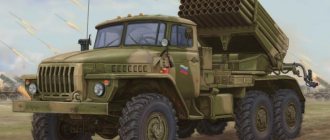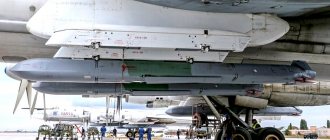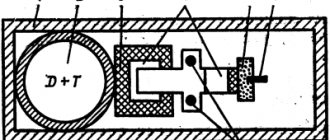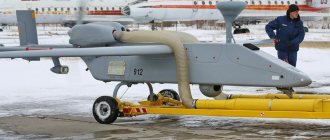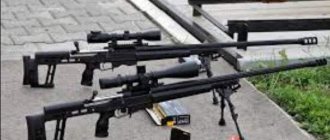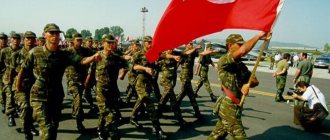Why was the Perimeter complex created?
At the height of the Cold War, the US military developed a “decapitation strike” system, in which a massive nuclear strike would be launched simultaneously against all military bases, missile force positions, the leadership of the military department and the country, as well as cities with Russia’s most important military installations.
To control the launch of missiles, in addition to the ground command, the United States created a backup command system, “Through the Looking Glass.” It was based on 11 Boeing EC-135C aircraft, converted into air command posts, which were constantly in the air, duplicating the command system of strategic forces. Their duty, starting in 1961, lasted almost 30 years.
In response to the aggressive policy of the United States, the domestic Perimeter system was created in the Soviet Union, the task of which was to ensure a retaliatory nuclear strike in any situation, even if the command posts and communication lines of the missile forces were completely destroyed. Such a system was soon created. The task was entrusted to specialists from the Yuzhnoye SDO.
“Dead hand” or “wild barbarity of the Russians”
Everyone is discussing Kiselyov with his phrase that Russia is the only country that is “capable of turning the United States into radioactive ash.” The presenter of Vesti Nedeli briefly spoke about the Perimeter system of guaranteed nuclear retaliation. And he noted that it was after the release of the material about “Perimeter” that the US President began to call his colleague from Russia more often and began to turn grayer...
So, "Dead Hand"
«Our strategic nuclear forces (SNF) are configured in such a way as to threaten Russian nuclear and economic facilities. Even while we are negotiating with Russian President Vladimir Putin, we are keeping his Kremlin office at gunpoint. This is the truth of life
— Joseph Cirincione, director of the Nuclear Nonproliferation Project at the Carnegie Endowment for International Peace. December 2001.
Russia has the only weapon in the world that guarantees a retaliatory nuclear strike against the enemy, even in the terrible event that we no longer have anyone to decide on this strike. The unique system counterattacks automatically – and brutally.
Command missile 15A11 of the Perimeter system
The Perimeter system (Strategic Missile Forces air defense index: 15E601) is a complex for automatic control of a massive retaliatory nuclear strike, created in the USSR at the height of the Cold War. Designed to guarantee the launch of silo-based ICBMs and SLBMs in the event that, as a result of a crushing nuclear strike by the enemy on the territory of the USSR, all command units of the Strategic Missile Forces capable of ordering a retaliatory strike are destroyed. The system is a backup communications system used in the event of the destruction of the Kazbek command system and the combat control systems of the Strategic Missile Forces, Navy and Air Force.
The system is the only doomsday machine (weapon of guaranteed retribution) in existence in the world, the existence of which has been officially confirmed. The system is still classified and may still be on combat duty to this day, so any information about it cannot be confirmed as unequivocally reliable, or refuted, and should be viewed with a due degree of skepticism.
In the mid-1970s, the development of a control system for strategic missile forces - the Strategic Missile Forces - began in Leningrad. In the documents it received the name “Perimeter”. The system involved the creation of such technical means and software that would make it possible, in any conditions, even the most unfavorable, to convey the order to launch missiles directly to the launch teams. According to the creators of Perimeter, the system could prepare and launch missiles even if everyone died and there was no one to give the order. This component became unofficially called the “Dead Hand”.
When creating a new control system for the Strategic Missile Forces, two important questions had to be answered. Firstly: how to make soulless automation understand that its time has come? Secondly: how to give it the ability to turn on exactly at the moment when it is needed, not earlier and not later? Naturally, there were other issues - perhaps not so important individually, but global in the aggregate.
Creating a reliable system with such parameters is extremely difficult. However, the wizards from the Soviet military-industrial complex were able to come up with such a scheme for Armageddon that they themselves became afraid. But on the other hand, there was also pride among professionals who had done something that no one had ever been able to do before. But how?
Any missile, especially one equipped with a nuclear warhead, can take off only if there is a corresponding order. In peacetime, during firing exercises (with a dummy warhead instead of a real warhead), this happens as simply as usual. The launch command is transmitted through the command communication lines, after which all locks are removed, the engines are ignited, and the rocket is carried off into the distance. However, in a real combat situation, in the event of various kinds of interference, this would be much more difficult to do. As in the hypothetical scenario of a surprise nuclear strike that we presented at the beginning of the article, communication lines could be knocked out, and the people who had the authority to give the decisive order could be destroyed. But who knows what could happen in the chaos that would certainly arise after a nuclear strike?
The logic of the Dead Hand’s actions involved the regular collection and processing of a gigantic amount of information. A variety of information was received from all kinds of sensors. For example, about the state of communication lines with a higher command post: there is a connection - there is no connection. About the radiation situation in the surrounding area: normal level of radiation - increased level of radiation. About the presence of people at the starting position: there are people - there are no people. About registered nuclear explosions and so on and so forth.
The “Dead Hand” had the ability to analyze changes in the military and political situation in the world - the system assessed commands received over a certain period of time, and on this basis could conclude that something was wrong in the world. In a word, it was a smart thing. When the system believed that its time had come, it became active and launched a command to prepare for the launch of the rockets.
Moreover, the “Dead Hand” could not begin active operations in peacetime. Even if there was no communication, even if the entire combat crew left the starting position, there were still a lot of other parameters that would block the operation of the system.
The Perimeter system with its main component, the Dead Hand, was put into service in 1983. The first information about it became known in the West only in the early 1990s, when some of the developers of this system moved there. On October 8, 1993, The New York Times published an article by its columnist Bruce Blair, “The Russian Doomsday Machine,” in which for the first time information about the control system of the Russian missile forces appeared in the open press. At the same time, its top-secret name, “Perimeter,” was announced for the first time, and a new concept, “dead hand,” entered the English language. Some in the West called the “Perimeter” system immoral, but at the same time even its most ardent critics were forced to admit that it is, in fact, the only deterrent that provides real guarantees that a potential enemy will refuse to launch a preventive nuclear strike.
mountain "Kosvinsky stone"
Silo UR-100N UTTH
It’s not for nothing that they say that fear rules the world. As for immorality, then... what is the “immorality” of retaliating? The Perimeter system is a backup command system for all branches of the military armed with nuclear warheads. It is designed to be particularly resistant to all damaging factors of nuclear weapons, and it is almost impossible to disable it. Its task is to make a decision on a retaliatory strike independently, without the participation (or with minimal participation) of a person. Only if the key nodes of the Kazbek command system (“nuclear suitcase”) and the communication lines of the Strategic Missile Forces (RVSN) are destroyed by the first strike in accordance with the “highly moral” concepts of “Limited Nuclear War” and “Decapitation Strike” ", developed in the USA. In peacetime, the main components of the Perimeter system are in standby mode. They assess the situation by processing data coming from measuring posts.
In addition to the extreme algorithm described above, there were also intermediate modes. One of them is worth telling in more detail.
On November 13, 1984, the 15A11 command missile, created in Dnepropetrovsk, at the Yuzhnoye Design Bureau, was tested; all American intelligence assets worked in a very intense mode. The command rocket was the intermediate option mentioned above. It was planned to be used in the event that communication between the command and missile units scattered throughout the country was completely interrupted. It was then that the order was supposed to be given from the General Staff in the Moscow region or from the reserve command post in Leningrad to launch 15A11. The missile was supposed to launch from the Kapustin Yar test site or from a mobile launcher, fly over those areas of Belarus, Ukraine, Russia and Kazakhstan where the missile units were stationed, and give them the command to take off.
On a November day in 1984, this is exactly what happened: the command rocket issued a command to prepare and launch from Baikonur the R-36M (15A14) - which later became the legendary “Satan”. Well, then everything happened as usual: “Satan” took off, rose into space, and a training warhead separated from it, which hit a training target at the Kura training ground in Kamchatka. (Detailed technical characteristics of the command rocket, if this issue is of particular interest to someone, can be found in books that have been published in abundance in Russian and English in recent years.)
In the early 70s, taking into account the real possibilities of highly effective methods of electronic suppression by a potential enemy of the Strategic Missile Forces' combat command and control systems, it became a very urgent task to ensure the delivery of combat orders from the highest echelons of command (the General Staff of the USSR Armed Forces, the Strategic Missile Forces Directorate) to command posts and individual launchers of strategic missiles on combat duty in case of emergency.
The idea arose to use for these purposes, in addition to the existing communication channels, a special command missile equipped with a powerful radio transmitting device, launched at a special period and giving commands to launch all missiles on combat duty throughout the USSR.
The development of a special command missile system, called “Perimeter”, was assigned to the Yuzhnoye Design Bureau by USSR Government Decree N695-227 of August 30, 1974. It was initially planned to use the MR-UR100 (15A15) missile as the base missile; later they settled on the MR-UR100 UTTH (15A16) missile. The missile, modified in terms of its control system, received the index 15A11.
The cover of the compartment with maintenance-free equipment is impenetrable, what is there is not known for certain
In December 1975 The preliminary design of the command rocket was completed. The rocket was equipped with a special warhead, indexed 15B99, which included an original radio engineering system developed by OKB LPI. To ensure the conditions for its functioning, the warhead had to have a constant orientation in space during flight. A special system for its calming, orientation and stabilization was developed using cold compressed gas (taking into account the experience of developing the propulsion system for the Mayak SNG), which significantly reduced the cost and time of its creation and testing. The production of SGC 15B99 was organized at NPO Strela in Orenburg.
After ground testing of new technical solutions in 1979. LCT of the command rocket began. At NIIP-5, sites 176 and 181, two experimental mine launchers were put into operation. In addition, a special command post was created at site 71, equipped with newly developed unique combat control equipment to provide remote control and launch of a command missile according to orders coming from the highest echelons of the Strategic Missile Forces control. At a special technical position in the assembly building, a shielded anechoic chamber was built, equipped with equipment for autonomous testing of the radio transmitter.
Flight tests of the 15A11 missile (see layout diagram) were carried out under the leadership of the State Commission headed by Lieutenant General V.V. Korobushin, First Deputy Chief of the Main Staff of the Strategic Missile Forces.
The first launch of the 15A11 command rocket with an equivalent transmitter was successfully carried out on December 26, 1979. The developed complex algorithms for interfacing all systems involved in the launch were tested, the ability of the missile to ensure the given flight path of the MC 15B99 (trajectory apex at an altitude of about 4000 km, range 4500 km), the operation of all service systems of the MC in normal mode, and the correctness of the adopted technical solutions was confirmed.
10 missiles were allocated for flight testing. In connection with the successful launches and the accomplishment of the assigned tasks, the State Commission considered it possible to be satisfied with seven launches.
During the testing of the Perimeter system, real launches of 15A14, 15A16, 15A35 missiles were carried out from combat facilities according to orders transmitted by the SGCh 15B99 in flight. Previously, additional antennas were mounted on the launchers of these missiles and new receiving devices were installed. All launchers and command posts of the Strategic Missile Forces subsequently underwent these modifications.
The 15P716 launcher is a silo-type, automated, highly protected, “OS” type. The key components of this system are the 15A11 command missile and receiving devices that ensure the reception of orders and codes from command missiles. The 15A11 command missile of the Perimeter system is the only widely known component of the complex. They have the index 15A11, developed by Yuzhnoye Design Bureau on the basis of the MR UR-100U missiles (index 15A16). Equipped with a special warhead (index 15B99), containing a radio engineering command system developed by OKB LPI. The technical operation of the missiles is identical to the operation of the base 15A16 missile. The launcher is silo-type, automated, highly protected, most likely OS type - a modernized OS-84 launcher. The possibility of basing missiles in other types of launch silos cannot be ruled out.
Along with flight tests, a ground test of the functionality of the entire complex was carried out under the influence of the damaging factors of a nuclear explosion at the test site of the Kharkov Institute of Physics and Technology, in the testing laboratories of VNIIEF (Sarov), and at the Novaya Zemlya nuclear test site. The tests carried out confirmed the operability of the control system and SGCh equipment at levels of exposure to a nuclear explosion exceeding those specified in the TTT MO.
Even during the flight tests, a government decree set the task of expanding the functions solved by the command missile complex, with the delivery of combat orders not only to Strategic Missile Forces facilities, but also to strategic missile submarines, long-range and naval missile-carrying aircraft at airfields and in the air, points control of the Strategic Missile Forces, Air Force and Navy.
The flight tests of the command missile were completed in March 1982. In January 1985, the complex was put on combat duty. For more than 10 years, the command missile complex has successfully fulfilled its important role in the defense capability of the state.
Many enterprises and organizations from various ministries and departments took part in the creation of the complex. The main ones are: NPO "Impulse" (V.I. Melnik), NPO AP (N.A. Pilyugin), KBSM (A.F. Utkin), TsKBTM (B.R. Aksyutin), MNIIRS (A.P. Bilenko), VNIIS (B.Ya. Osipov), Central Design Bureau "Geophysics" (G.F. Ignatiev), NII-4 MO (E.B. Volkov).
TECHNICAL DESCRIPTION
There is no reliable information about the 15E601 “Perimeter” system, however, based on indirect evidence, it can be assumed that it is a complex expert system equipped with many communication systems and sensors. The system probably has the following operating principle.
The system is located on the database and receives data from tracking systems, including early warning radars. The system has its own stationary and mobile combat control centers. In these centers, the main component of the Perimeter system operates - an autonomous control and command system - a complex software complex created on the basis of artificial intelligence, connected to a variety of communication systems and sensors that monitor the situation.
In peacetime, the main components of the system are in standby mode, monitoring the situation and processing data received from measuring posts.
In the event of a threat of a large-scale attack using nuclear weapons, confirmed by data from early warning systems about a missile attack, the Perimeter complex is automatically put on alert and begins to monitor the operational situation.
This is how the system is believed to work. “Perimeter” is on constant combat duty; it receives data from tracking systems, including early warning radars for missile attacks. Apparently, the system has its own independent command posts, which are in no way (outwardly) indistinguishable from many similar points of the Strategic Missile Forces. According to some reports, there are 4 such points, they are separated over a long distance and duplicate each other’s functions.
At these points, the most important - and most secret - component of the Perimeter, the autonomous control and command system, operates. It is believed that this is a complex software system created on the basis of artificial intelligence. By receiving data on communications on the air, the radiation field and other radiation at control points, information from early detection systems for launches, seismic activity, it is able to draw conclusions about the fact of a massive nuclear attack.
If “the situation is ripe,” the system itself is transferred to a state of full combat readiness. Now she needs one last factor: the absence of regular signals from the usual command posts of the Strategic Missile Forces. If signals have not been received for some time, “Perimeter” triggers the Apocalypse.
15A11 command missiles are released from the silos. Created on the basis of the MR UR-100 intercontinental missiles (launch weight 71 tons, flight range up to 11 thousand km, two stages, liquid-propellant jet engine), they carry a special warhead. In itself, it is harmless: it is a radio engineering system developed at the St. Petersburg Polytechnic. These missiles, rising high into the atmosphere and flying over the territory of the country, broadcast launch codes for all nuclear missile weapons.
They also act automatically. Imagine a submarine standing at the pier: almost the entire crew on the shore has already died, and only a few confused submariners on board. Suddenly she comes to life. Without any outside intervention, having received a launch signal from strictly secret receiving devices, the nuclear arsenal begins to move. The same thing happens in immobilized silo installations and in strategic aviation. A retaliatory strike is inevitable: it is probably unnecessary to add that the Perimeter is designed to be especially resistant to all damaging factors of nuclear weapons. It is almost impossible to reliably disable it.
antenna
radio channel of the combat control system
The system monitors: • the presence and intensity of conversations on air at military frequencies, • information from early warning systems, • receiving telemetry signals from Strategic Missile Forces posts, • radiation levels on the surface and in the surrounding area, • regular occurrence of point sources of powerful ionizing and electromagnetic radiation at key coordinates, coinciding with sources of short-term seismic disturbances in the earth's crust (which corresponds to the picture of multiple ground-based nuclear strikes), • the presence of living people at the command post.
Based on the correlation of these factors, the system probably makes the final decision about the fact of a massive nuclear attack and the need to launch a retaliatory nuclear strike.
Another proposed option for the system’s operation is that upon receiving information about the first signs of a missile attack from the early warning system, the top officials of the state could switch the system to combat mode. After this, if within a certain time the system’s control center does not receive a signal to stop the combat algorithm, then the procedure for delivering a retaliatory nuclear strike is initialized. This completely excluded the possibility of making a decision on a retaliatory strike in the event of a false alarm and ensured that even the destruction of everyone who has the authority to issue a command for launches would not be able to prevent a retaliatory nuclear strike.
If the sensor components of the system confirm with sufficient reliability the fact of a massive nuclear strike, and the system itself loses contact with the main command nodes of the Strategic Missile Forces for a certain time, the Perimeter system initiates the procedure for delivering a retaliatory nuclear strike, even bypassing the Kazbek system, better known for its the most noticeable element, the “Cheget” subscription kit, is like a “nuclear suitcase”.
After receiving an order from the Strategic Missile Forces VZU to a special command post, or at the command of the autonomous control and command system that is part of the Perimeter system, command missiles are launched (15A11, and subsequently 15Zh56 and 15Zh75). Command missiles are equipped with a radio command unit that transmits in flight a control signal and launch codes for launching to all carriers of strategic nuclear weapons located on the base.
To receive signals from the SSG of command missiles, all KP, PZKP, PKP RP and RDN, as well as APU, except for the Pioneer family complexes and 15P020 of all modifications, were equipped with special RBU receivers of the Perimeter system. At the stationary command centers of the Navy, Air Force, command posts of fleets and air armies, in the late 80s, equipment 15E646-10 of the Perimeter system was installed, incl. capable of receiving signals from command missiles. Further, orders for the use of nuclear weapons were communicated through their specific communications means of the Navy and Air Force. The receiving devices are hardware connected to the control and launch equipment, ensuring immediate autonomous execution of the launch order in a fully automatic mode, providing a guaranteed retaliatory strike against the enemy even in the event of the death of all personnel.
COMPOUND
The main elements of the Perimeter system: - an autonomous command system, which is part of stationary and mobile combat control centers; - command missile systems.
Divisions included in the Perimeter system:
URU GSh - control radio nodes of the General Staff of the Armed Forces, presumably: URU General Staff of the Aircraft: 624th PDRTs, military unit 44684.1 US GSh Ministry of Defense of the Russian Federation, (56° 4'58.07″N 37° 5'20.68″E)
URU Strategic Missile Forces - control radio nodes of the General Staff of the Strategic Missile Forces of the Russian Federation, presumably: URU General Staff of the Strategic Missile Forces of the 140th PDRTs, military unit 12407, PDRTs General Staff of the Strategic Missile Forces 143562, Moscow region, Istrinsky district, pos. Voskhod (Novopetrovskoe) (55° 56′ 18.14″N 36° 27′ 19.96″E)
Stationary CBU - stationary combat control center (CCU) of the Perimeter system, 1231 TsBU, military unit 20003, facility 1335, Sverdlovsk region, village. Kytlym (Mount Kosvinsky stone);
Mobile CBU - mobile combat control center (PCCU) of the Perimeter system, complex 15V206:
1353 TsBU, military unit 33220, Sumy region, Glukhov, 43rd rd (military unit 54196, Romny), 43rd RA (military unit 35564, Vinnitsa), 1990 – 1991. In 1991 redeployed to 59th rd, Kartaly.
1353 TsBU, military unit 32188, call sign “Perborshchik”, Kartaly, 1353 TsBU was part of the 59th rd, but due to its peculiarities and the nature of the tasks performed, it was directly subordinate to the General Staff of the Russian Federation, 1991 - 1995; In 1995, 1353 TsBU was included in the 59th RD (military unit No. 68547, Kartaly), 31st RA (military unit 29452, Orenburg). In 2005, 1353 TsBU was disbanded along with the 59th rd. 1193 CBU, military unit 49494, Nizhny Novgorod region, urban settlement Dalnee Konstantinovo-5 (Surovatikha), 2005 - ...;
15P011 - 15A11 command missile complex. 510th rp, BRK-6, military unit 52642, 7th rd (military unit 14245, Vypolzovo (Bologoe-4, ZATO “Ozerny”)) 27th RA (military unit 43176, Vladimir), January 1985 – June 1995;
There is also evidence that previously the Perimeter system, along with 15A11 missiles, included command missiles based on the Pioneer MRBM. Such a mobile complex with “pioneer” command missiles was called “Gorn”. The complex index is 15P656, the missiles are 15Zh56. It is known about at least one unit of the Strategic Missile Forces, which was armed with the Horn complex - the 249th Missile Regiment, stationed in the city of Polotsk, Vitebsk Region, 32nd Missile Division (Postavy), from March-April 1986 to 1988 was on combat duty with a mobile complex of command missiles.
15P175 “Sirena” is a mobile ground-based command missile system (PGRK KR).
In December 1990, in the 8th Missile Division (urban town of Yurya), a regiment (commander - Colonel S.I. Arzamastsev) with a modernized command missile system, called “Perimeter-RC”, which included a command missile, took up combat duty , created on the basis of the RT-2PM Topol ICBM.
Mobile ground-based command missile system (PGRK KR). 8th rd (military unit 44200, Yurya-2), 27th RA (military unit 43176, Vladimir), 10/01/2005 - ...
76th rp (military unit 49567, BSP-3): 1 and 2 GPP - 1st division 3 GPP and GBU - 2nd division
304th rp (military unit 21649, BSP-31): 4 and 5 GPP - 1st division 6 GPP and GBU - 2nd division
776th rp (military unit 68546, BSP-18): 7 and 8 GPP - 1st division 9 GPP and GBU - 2nd division
After being put on combat duty, the 15E601 “Perimeter” system was periodically used during command post exercises.
In November 1984, after the launch of the 15A11 command rocket and the exit of the 15B99 command rocket to the passive part of the trajectory, the SGCH issued a command to launch the 15A14 rocket (R-36M, RS-20A, SS-18 “Satan”) from the NIIP-5 test site (Baikonur Cosmodrome) . Subsequently, everything happened as expected - launch, testing of all stages of the 15A14 rocket, separation of the training warhead, hitting the target square at the Kura training ground, in Kamchatka.
In December 1990, a modernized system was put into service, called “Perimeter-RC”, which operated until June 1995, when, as part of the START-1 agreement, the complex was removed from combat duty. It is quite possible that the Perimeter complex should be modernized so that it can quickly respond to an attack by non-nuclear Tomahawk cruise missiles.
According to unverified data, the system was already returned to combat duty in 2001 or 2003.
And some more evidence on this topic:
«The USSR developed a system that became known as the “Dead Hand”. What did this mean? If a nuclear attack was carried out on a country, and the Commander-in-Chief could not make any decision, among the intercontinental missiles that were at the disposal of the USSR, there were those that could be launched via a radio signal from the system commanding the battle
“says Doctor of Engineering Sciences Petr Belov.
Using a complex system of sensors that measured seismic activity, air pressure, and radiation to determine whether the USSR was being attacked by a nuclear weapon, the Dead Hand provided the ability to launch a nuclear arsenal without anyone pressing the red button. If contact with the Kremlin were lost and the computers detected an attack, the launch codes would be activated, giving the USSR the opportunity to retaliate after its destruction.
«A system that can be automatically activated upon the first enemy strike is actually necessary. Its very presence makes it clear to enemies that even if our command centers and decision-making systems are destroyed, we will have the opportunity to launch an automated retaliatory strike
“, said the former head of the Main Directorate of International Military Cooperation of the Ministry of Defense of the Russian Federation, Colonel General Leonid Ivashov.
During the Cold War, the United States had its own “backup option,” codenamed “Mirror.” Crews have been in the air continuously for three decades, with the mission to control the skies should control of the ground be lost due to a surprise attack. The main difference between the Dead Hand and the Mirror is that the Americans relied on people to warn them about the attack. After the Cold War, the United States abandoned this system, although it is still unclear whether a Soviet version exists. Those who know about this avoid talking about this topic. “ I can’t talk about this because I don’t know about the current state of affairs
", says Ivashov.
“Operation Looking Glass” (“Mirror”) - air command posts (ACCP) of the US Strategic Air Command (SAC) on Boeing EC-135C aircraft (11 units), and later, from July 1989, on E-6B " Mercury" (Boeing 707-320) (16 units). 24 hours a day, for more than 29 years, from February 3, 1961 to June 24, 1990, two Looking Glass aircraft were constantly in the air - one over the Atlantic, the other over the Pacific Ocean. In total, 281,000 hours were spent in the air. The crews of the All-Union Communist Party, consisting of 15 people, including at least one general, were in constant readiness to take command of strategic nuclear forces in the event of the defeat of ground command posts.
The main difference between Perimeter and Mirror is that the Americans relied on people to take command and make the decision to launch a nuclear retaliatory strike. After the end of the Cold War, the United States abandoned this system for carrying a combat vehicle and currently the VKP are on duty at 4 air bases in constant readiness for takeoff.
Also in the USA there was a complex of command missiles - UNF Emergency Rocket Communications System (ERCS). The system was first fielded on July 11, 1963, at launch sites at Wisner, West Point, and Tekamah, Nebraska, as part of three MER-6A Blue Scout Junior missiles. The system was on the database until December 1, 1967. Subsequently, the modernized ERCS was based on the Minuteman series missiles - LEM-70 (based on Minuteman I since 1966) and LEM-70A (based on Minuteman II since 1967) (Project 494L). The upgraded system was delivered to the database on October 10, 1967 at Whiteman AFB, Missouri, as part of ten silo launchers. The system was removed from the database at the beginning of 1991.
sources
https://masterok.livejournal.com/501495.html https://www.cosmoworld.ru/spaceencyclopedia/publications/index.shtml?zhelez_22.html - Alexander Zheleznyakov
https://www.inosmi.ru/multimedia/20091215/157016951.html https://usa-army.ru/yadernaya-strategiya.html https://pioneer-club.org.ua/publ/sistema_15eh601_perimetr_mertvaja_ruka_oruzhie_vozmezdija_sssr/1- 1-0-98 https://www.wired.com/politics/security/magazine/17-10/mf_deadhand?currentPage=all
If you liked this material, I would be grateful if you share it on social networks:
This material is subject to copyright. Full or partial publication of a post, as well as photographs posted in it, without my consent is PROHIBITED
in any media, print publications, on any websites and social networks.
Email for offers and purchasing photos: [email protected]
What is the Perimeter complex?
“Perimeter” is a coherent, large complex, dispersed across Russian territory, which constantly controls the control parameters of all 1,800 nuclear warheads, although 200 modern nuclear warheads are quite enough to destroy a country like the United States.
The development of a backup retaliatory strike system arose in connection with the increased threat of unauthorized penetration into the command and control structure of strategic nuclear forces. To do this, a backup communication method was needed that would guarantee launch commands to all launchers.
As such a communication channel, it was proposed to use special command missiles equipped with powerful radio control equipment. Flying over the territory of the Soviet Union, such a missile would give commands to launch ballistic missiles based at different points. Already in November 1984, a command rocket launched from near Polotsk managed to transmit a signal to launch a silo launcher in the Baikonur area. The Satan, which took off from the mine, successfully hit a target at the Kamchatka training ground. In January 1985, the Perimeter system went on combat duty.
System operation
So, let’s imagine that all the horrors of the Third World War came true: our country was attacked and the government, along with the entire top military command, was destroyed with targeted strikes. This is where Perimeter comes into play. A special command missile takes off from an underground point - in flight it will transmit launch commands to intercontinental ballistic missiles. Each of them already has a destination in memory. Retribution is inevitable.
How does the Dead Hand system work?
Carrying out combat duty, stationary observation stations of various ranges "Voronezh", as well as other mobile centers, constantly monitor seismic activity on the planet, measure the level of radiation, temperature in various layers of the atmosphere, and monitor data from the missile attack warning system. After analyzing this and many other data, the complex can autonomously decide on a retaliatory nuclear attack. But this can only happen if the following conditions are met:
- by analyzing the received data, the system verifies the fact of a nuclear attack;
- the presence of communication with the General Staff is tested, when the fact of existence is confirmed, the system is turned off;
- in the absence of communication with the General Staff, “Perimeter” requests the “Kazbek” system. If there is no answer here, the artificial intelligence transfers the right to make decisions to any person located in the control bunker;
- only after all these conditions have been checked, the system begins to act on its own, giving the command to launch the command rocket.
The location of the command missile is strictly classified. In addition, backup systems have been created, installed on air-, submarine- and space-based missiles, capable of protecting each other.
